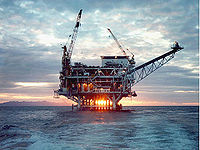- Mass transfer
-
Part of Chemical engineering
Concepts- Unit operations
- Unit processes
- Chemical engineer
- Chemical process
- Process integration
Unit operations- Momentum transfer
- Heat transfer
- Mass transfer
- Mechanical operations
- Chemical reaction engineering
- Chemical kinetics
- Chemical process modeling
- Chemical technology
- Process integration
Branchesothers
Mass transfer is the net movement of mass from one location, usually meaning a stream, phase, fraction or component, to another. Mass transfer occurs in many processes, such as absorption, evaporation, adsorption, drying, precipitation, membrane filtration, and distillation. Mass transfer is used by different scientific disciplines for different processes and mechanisms. The phrase is commonly used in engineering for physical processes that involve diffusive and convective transport of chemical species within physical systems.
Some common examples of mass transfer processes are the evaporation of water from a pond to the atmosphere, the purification of blood in the kidneys and liver, and the distillation of alcohol. In industrial processes, mass transfer operations include separation of chemical components in distillation columns, absorbers such as scrubbers, adsorbers such as activated carbon beds, and liquid-liquid extraction. Mass transfer is often coupled to additional transport processes, for instance in industrial cooling towers. These towers couple heat transfer to mass transfer by allowing hot water to flow in contact with hotter air and evaporate as it absorbs heat from the air.
Contents
Astrophysics
In astrophysics, mass transfer is the process by which matter gravitationally bound to a body, usually a star, fills its Roche lobe and becomes gravitationally bound to a second body, usually a compact object (white dwarf, neutron star or black hole), and is eventually accreted onto it. It is a common phenomenon in binary systems, and may play an important role in some types of supernovae and pulsars.
Chemical Engineering
Mass transfer finds extensive application in chemical engineering problems. It is used in reaction engineering, separations engineering, heat transfer engineering, and many other sub-disciplines of chemical engineering.
The driving force for mass transfer is typically a difference in chemical potential, when it can be defined, though other thermodynamic gradients may couple to the flow of mass and drive it as well. A chemical species moves from areas of high chemical potential to areas of low chemical potential. Thus, the maximum theoretical extent of a given mass transfer is typically determined by the point at which the chemical potential is uniform. For single phase-systems, this usually translates to uniform concentration throughout the phase, while for multiphase systems chemical species will often prefer one phase over the others and reach a uniform chemical potential only when most of the chemical species has been absorbed into the preferred phase, as in liquid-liquid extraction.
While thermodynamic equilibrium determines the theoretical extent of a given mass transfer operation, the actual rate of mass transfer will depend on additional factors including the flow patterns within the system and the diffusivities of the species in each phase. This rate can be quantified through the calculation and application of mass transfer coefficients for an overall process. These mass transfer coefficients are typically published in terms of dimensionless numbers, often including Péclet numbers, Reynolds numbers, Sherwood numbers and Schmidt numbers, among others[1].
Analogies between heat, mass, and momentum transfer
Main article: Transport phenomenaThere are notable similarities in the commonly used approximate differential equations for momentum, heat, and mass transfer.[1] The molecular transfer equations of Newton's law for fluid momentum at low Reynolds number (Stokes flow), Fourier's law for heat, and Fick's law for mass are very similar, since they are all linear approximations to transport of conserved quantities in a flow field. At higher Reynolds number, the analogy between mass and heat transfer and momentum transfer becomes less useful due to the nonlinearity of the Navier-Stokes equation (or more fundamentally, the general momentum conservation equation), but the analogy between heat and mass transfer remains good. A great deal of effort has been devoted to developing analogies among these three transport processes so as to allow prediction of one from any of the others.
References
- ^ a b Welty, James R.; Wicks, Charles E.; Wilson, Robert Elliott (1976). Fundamentals of momentum, heat, and mass transfer (2 ed.). Wiley. http://books.google.be/books?cd=3&hl=en&id=hZxRAAAAMAAJ.
See also
- Crystal growth
- Heat transfer
- Fick's laws of diffusion
- Distillation column
- McCabe-Thiele method
- Vapor-Liquid Equilibrium
- Liquid-liquid extraction
- Separation process
- Binary star
- Type Ia supernova
- Accretion (astrophysics)

Concepts Unit operations Unit process Branches Process design · Fluid mechanics · Chemical plant Design · Chemical thermodynamics · Transport phenomena · *More*Others Outline of chemical engineering · Index of chemical engineering articles · Education for Chemical Engineers · List of chemical engineers · List of chemical engineering societies · List of chemical process simulatorsCategories:- Chemical engineering
- Transport phenomena
- Mechanical engineering
- Heating, ventilating, and air conditioning
Wikimedia Foundation. 2010.
